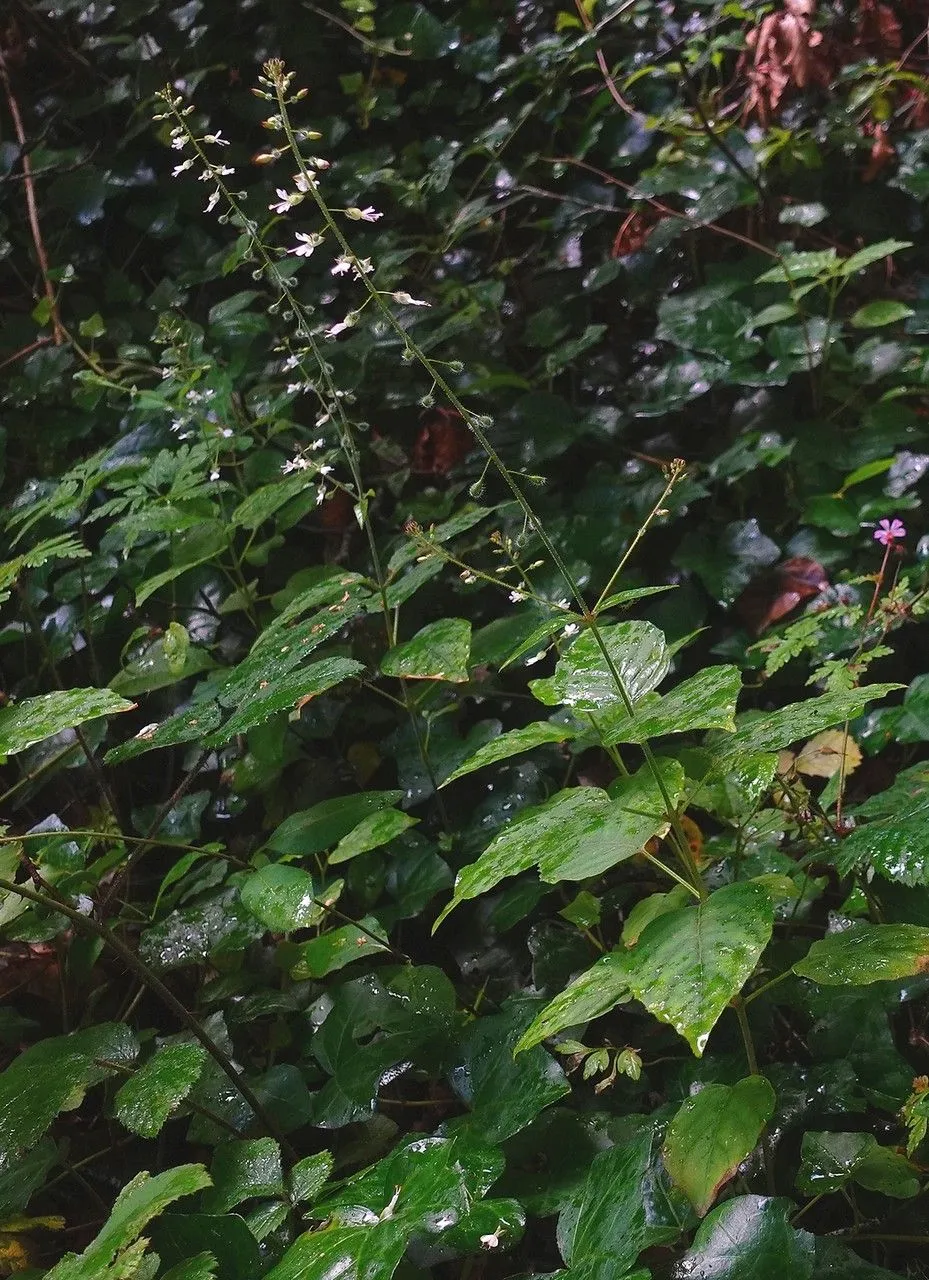
Author: L.
Bibliography: Sp. Pl.: 9 (1753)
Year: 1753
Status: accepted
Rank: species
Genus: Circaea
Vegetable: False
Observations: Europe to Kazakhstan, Medit. to Iran
Enchanter’s-nightshade is an intriguing plant with a name that evokes a sense of mystery and enchantment. Scientifically known as Circaea lutetiana, this plant was first formally described in 1753 by the renowned botanist Carl Linnaeus in his work Species Plantarum.
Belonging to the Onagraceae family, Enchanter’s-nightshade is widespread across various regions, ranging from Europe to Kazakhstan, and extending from the Mediterranean to Iran. This geographical distribution indicates the plant’s adaptability to various climatic conditions and terrains.
The plant typically grows in shaded, forested areas where it thrives in the rich, moist soil of deciduous forests. With delicate, white to pinkish flowers, Enchanter’s-nightshade often goes unnoticed due to its modest and inconspicuous appearance. The flowers are small, typically about 3-4 mm in diameter, and form in loose clusters.
Despite its name, Enchanter’s-nightshade is not associated with the Solanaceae family, which includes other nightshades known for their toxic properties. Instead, it is safely nestled within Onagraceae, a family that includes the evening primroses. The etymology of its common name is shrouded in folklore, often thought to be connected to some old myths and superstitions, possibly due to its elusive nature and shadowy habitat.
The plant’s stems are characteristically soft and hairy, with leaves that are ovate or heart-shaped and have a somewhat dentate or toothed margin. The plant can propagate through rhizomes, allowing it to form colonies under optimal conditions. In some traditions, Enchanter’s-nightshade has been used in herbal remedies, although it is not particularly well-known for medicinal properties.
In an ecological context, Enchanter’s-nightshade serves as an understory plant, providing ground cover and contributing to the biodiversity of forest floors. Its flowers, although minor, attract small pollinators, thus playing a modest role in the ecosystem. The plant’s fruit are small burr-like structures that facilitate seed dispersal by attaching to passing animals.
Overall, Circaea lutetiana, or Enchanter’s-nightshade, stands as a fascinating example of the subtle complexity and historical ties that many plants offer to the diligent observer and botanical enthusiast.
Eng: broadleaf enchanter’s nightshade, enchanter’s-nightshade, common enchanter’s nightshade, enchanter’s nightshade
Dan: dunet steffensurt
Deu: gemeines hexenkraut, gewöhnliches hexenkraut
Fra: circée de paris
Nld: groot heksenkruid
Lav: liela raganzalite
Swe: stor häxört, storhäxört
Cym: gedor-wrach, llys steffan, llys steffan cyffredin, llysiau steffan, llysiau ystyffan, llysiau’r swynwr, mochlys duon, mochlys swynyddlys, swynlys, swynyddlys
En: Enchanter’s-nightshade, Broadleaf enchanter’s nightshade, BROAD-LEAF ENCHANTER’S-NIGHTSH, Ælfþone, Common Enchanter’s Nightshade, Enchanter’s Nightshade, Broadleaf Enchanter’s-nightshade, Philtrewort, Witch-flower
Ar: أبو سلام
Be: Двухпялёснік парыжскі
Bg: Едра чаровница
Ca: Circea comuna
Zh: 水珠草
Kw: Losow hudores
Cs: Čarovník pařížský
Da: Dunet Steffensurt
Nl: Groot heksenkruid
Et: Pori-nõiakold
Fi: Isovelholehti
Fr: Circée de paris, Circée commune, Circée des Parisiens, Circée parisienne, Enchanteresse, Herbe aux sorciers, Herbe de saint Étienne, Herbe des sorcières, Sorcière, Tierce
De: Gemeines Hexenkraut, Großes Hexenkraut, Gewöhnliches Hexenkraut, Pariser Hexenkraut
Hu: Erdei varázslófű
It: Erba-maga comune
Lv: Liela raganzalite
No: Stortrollurt
Fa: عشرق
Pl: Czartawa pospolita
Ro: Tilișcă
Ru: Двулепестник парижский
Sk: Čarovník obyčajný
Sv: Stor häxört, Storhäxört
Tt: Париж урманчәе
Ug: ئەبۇ سالام
Cy: Llysiau Steffan, Gedor-Wrach, Llys Steffan, Llys Steffan Cyffredin, Llysiau Ystyffan, Llysiau’r Swynwr, Mochlys Duon, Mochlys Swynyddlys, Swynlys, Swynyddlys
© copyright of the Board of Trustees of the Royal Botanic Gardens, Kew.
© copyright of the Board of Trustees of the Royal Botanic Gardens, Kew.
© copyright of the Board of Trustees of the Royal Botanic Gardens, Kew.
Taken Aug 9, 2019 by Clara Wagner (cc-by-sa)
Taken Sep 4, 2021 by Kai Best (cc-by-sa)
Taken Sep 17, 2019 by marlies schneider (cc-by-sa)
Taken Aug 4, 2021 by Pierre LEON (cc-by-sa)
Taken Aug 4, 2021 by Pierre LEON (cc-by-sa)
Taken Jul 18, 2021 by Pierre LEON (cc-by-sa)
Taken Sep 1, 2022 by John Sycorax (cc-by-sa)
Taken Jun 27, 2020 by Jäger Latein (cc-by-sa)
Taken Jun 27, 2020 by Jäger Latein (cc-by-sa)
Taken Aug 4, 2021 by Pierre LEON (cc-by-sa)
Taken Aug 13, 2020 by Lennaert Steen (cc-by-sa)
Taken Jul 23, 2022 by Kai Best (cc-by-sa)
Taken Jul 16, 2020 by sean pyman (cc-by-sa)
Taken Aug 11, 2021 by pascal derouault (cc-by-sa)
Taken Aug 4, 2021 by Pierre LEON (cc-by-sa)
Taken Sep 7, 2020 by Darren Giddins (cc-by-sa)
Taken Sep 23, 2022 by David Hocken (cc-by-sa)
Taken Sep 23, 2022 by David Hocken (cc-by-sa)
Taken Sep 14, 2022 by Fabrice Rubio (cc-by-sa)
Taken Sep 8, 2022 by Llandrich anna (cc-by-sa)
Taken Jul 18, 2015 by Maurice Maeck (cc-by-sa)
Taken Sep 6, 2014 by Tela Botanica − Liliane Roubaudi (cc-by-sa)
Taken Sep 6, 2014 by Tela Botanica − Liliane Roubaudi (cc-by-sa)
Taken Aug 18, 2014 by Tela Botanica − Marcel ETIENNE (cc-by-sa)
Taken Aug 18, 2014 by Tela Botanica − Marcel ETIENNE (cc-by-sa)
Taken Jul 21, 2021 by Hélène (cc-by-sa)
Taken Jul 28, 2022 by stéphane COLLE (cc-by-sa)
Taken Jun 18, 2004 by EOL − Steven J. Baskauf (cc-by-nc-sa)
Taken Jul 3, 2010 by Tela Botanica − Yoan MARTIN (cc-by-sa)
Taken Jul 7, 2012 by Tela Botanica − Yoan MARTIN (cc-by-sa)
Growth habit: Forb/herb
Ph maximum: 7.0
Ph minimum: 6.5
Light: 4
Atmospheric humidity: 8
Bloom months: [‘jun’, ‘jul’, ‘aug’, ‘sep’]
Soil nutriments: 6
Family: Myrtaceae Author: (F.Muell.) K.D.Hill & L.A.S.Johnson Bibliography: Telopea 6: 402 (1995) Year: 1995 Status:…
Family: Rubiaceae Author: Pierre ex A.Froehner Bibliography: Notizbl. Bot. Gart. Berlin-Dahlem 1: 237 (1897) Year:…
Family: Sapindaceae Author: Koidz. Bibliography: J. Coll. Sci. Imp. Univ. Tokyo 32(1): 38 (1911) Year:…
Family: Asteraceae Author: A.Gray Bibliography: Pacif. Railr. Rep.: 107 (1857) Year: 1857 Status: accepted Rank:…
Family: Fabaceae Author: Medik. Bibliography: Vorles. Churpfälz. Phys.-Ökon. Ges. 2: 398 (1787) Year: 1787 Status:…
Family: Aspleniaceae Author: (Cav.) Alston Bibliography: Bull. Misc. Inform. Kew 1932: 309 (1932) Year: 1932…